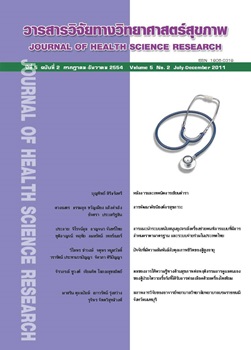ปัจจัยที่มีความสัมพันธ์กับคุณภาพชีวิตของผู้สูงอายุ
Main Article Content
บทคัดย่อ
บทคัดย่อ
การวิจัยครั้งนี้เป็นวิจัยเชิงพรรณนา (descriptive research) เพื่อศึกษาคุณภาพชีวิตและความสัมพันธ์ระหว่างปัจจัยส่วนบุคคลกับคุณภาพชีวิตของผู้สูงอายุในตำบลบางกร่าง อำเภอเมือง จังหวัดนนทบุรี กลุ่มตัวอย่าง คือ ผู้สูงอายุที่ยินดีตอบแบบสอบถามการวิจัยและเข้าร่วมโครงการบริการวิชาการ จำนวน 345 คน เครื่องมือที่ใช้ในการวิจัยประกอบด้วย แบบบันทึกข้อมูลส่วนบุคคล แบบสอบถามความสามารถในการทำกิจวัตรประจำวันและแบบวัดคุณภาพชีวิตขององค์การอนามัยโลก ชุดย่อ ฉบับภาษาไทย (WHOQOl_BREF_THAI) เก็บรวบรวมข้อมูลโดยให้กลุ่มตัวอย่างตอบแบบสอบถามในช่วงของการลงทะเบียนและกิจกรรมการคัดกรองสุขภาพเบื้องต้น ก่อนที่จะให้ความรู้และคำปรึกษาในการดูแลสุขภาพในโครงการบริการวิชาการ วิเคราะห์ข้อมูลส่วนบุคคลและความสามารถในการทำกิจวัตรประจำวันโดยใช้สถิติเชิงพรรณนา ในส่วนของข้อมูลคุณภาพชีวิตใช้สถิติเชิงพรรณนา Chi-square และ Spearman rank correlationcoefficient
ผลการศึกษาพบว่า กลุ่มตัวอย่างมีคะแนนคุณภาพชีวิตโดยรวมอยู่ในระดับปานกลาง คิดเป็นร้อยละ 66.1 เมื่อพิจารณารายด้านพบว่า ทุกองค์ประกอบมีคะแนนคุณภาพชีวิตอยู่ในระดับปานกลาง โดยด้านร่างกายคิดเป็นร้อยละ 75.7ด้านจิตใจร้อยละ 53.7 ด้านสัมพันธภาพทางสังคมร้อยละ 66.0 และด้านสิ่งแวดล้อมร้อยละ 62.6 ตามลำดับ และพบว่าปัจจัยด้านเพศ อายุ สถานภาพสมรส ระดับการศึกษา รายได้และฐานะการเงินมีความสัมพันธ์อย่างมีนัยสำคัญทางสถิติกับคุณภาพชีวิตของผู้สูงอายุ
ผลการวิจัยครั้งนี้สามารถนำไปใช้เป็นข้อมูลพื้นฐานในการวางแผนช่วยเหลือและส่งต่อกับหน่วยงานที่เกี่ยวข้องรวมทั้งได้แนวทางในการให้บริการวิชาการโดยการให้ความรู้และคำแนะนำในการดูแลสุขภาพที่ตรงกับความต้องการของผู้สูงอายุ เพื่อให้ผู้สูงอายุมีคุณภาพชีวิตที่ดียิ่งขึ้น
คำสำคัญ: คุณภาพชีวิต; ผู้สูงอายุ
Abstract
The purposes of this descriptive research were to study the quality of life and examine therelationship between demographic factors and the quality of life of elderly in Bang Krang Subdistrict,Muang District, Nonthaburi Province. The sample consisted of 345 elderly who voluntarily participated inthe study and the academic service project. The research instruments included the demographic datarecord, Barthel ADL Index and WHOQOl_BREF_THAI questionnaires. The data were collected duringthe registration and physical health assessment periods before providing health education and counseling to the elderly. The data were analyzedby using descriptive statistics for demographic andability of daily living data. In addition, the data ofquality of life were analyzed by using descriptivestatistics, Chi-square and Spearman rankcorrelation coefficient.
The results of the study revealed thatoverall quality of life of the elderly was at themoderate level (66.1%). The scores of the qualityof life of physical, psychological, social relationshipand environmental domains also were at themoderate level with 75.7%, 53.7%, 66.0% and62.6%, respectively. In addition, the demographicfactors including gender, age, marital status,educational level, income and economic statushad a significant correlation with the quality of lifeof the elderly.
The study findings could be utilized as thebaseline data for the responsible organizations inthe community to develop the plan for improvingthe quality of life of the elderly. Furthermore, thefindings could be used for developing theguideline for providing the academic service whichmet the needs of the elderly.
Keywords: Quality of life; Elderly
Downloads
Article Details
บทความที่ได้รับการตีพิมพ์เป็นลิขสิทธิ์ของวิทยาลัยพยาบาลบรมราชชนนี จังหวัดนนทบุรี
ข้อความที่ปรากฏในบทความแต่ละเรื่องในวารสารวิชาการเล่มนี้เป็นความคิดเห็นส่วนตัวของผู้เขียนแต่ละท่านไม่เกี่ยวข้องกับวิทยาลัยพยาบาลบรมราชชนนี จังหวัดนนทบุรี และคณาจารย์ท่านอื่น ในวิทยาลัยฯ แต่อย่างใด ความรับผิดชอบองค์ประกอบทั้งหมดของบทความแต่ละเรื่องเป็นของผู้เขียนแต่ละท่าน หากมีความผิดพลาดใด ๆ ผู้เขียนแต่ละท่านจะรับผิดชอบบทความของตนเองแต่ผู้เดียว


